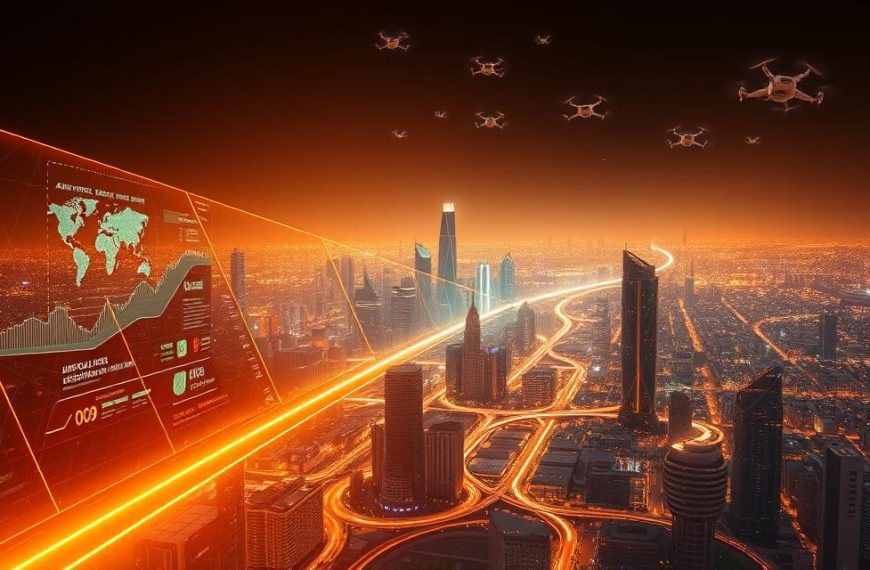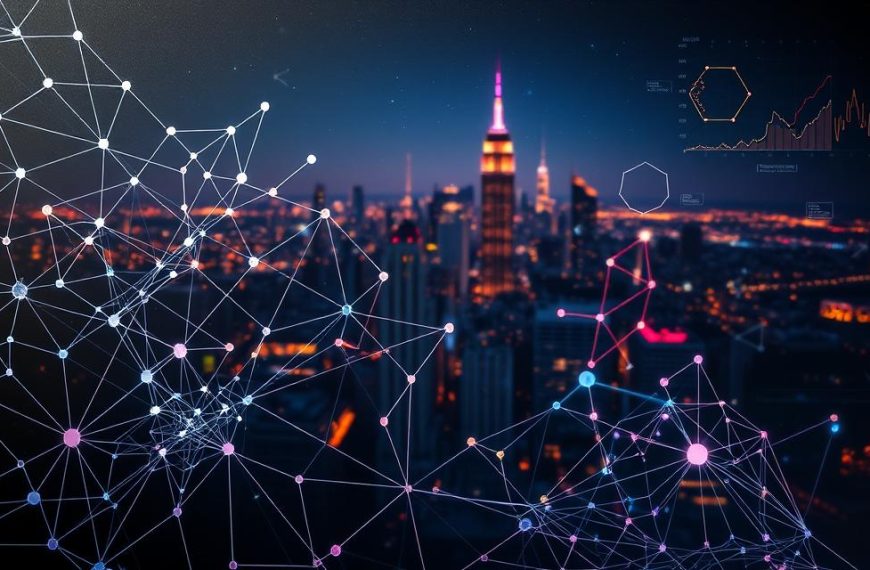Once a futuristic idea, AI now drives real-world solutions for companies worldwide. Over 70% of enterprises already use it to streamline workflows and boost efficiency. This shift is reshaping industries at an unprecedented pace.
Projections show a staggering $15.7 trillion economic impact by 2024. Organizations leveraging these tools gain clear competitive edges. From automating routine tasks to enhancing customer interactions, the applications keep expanding.
Key areas seeing transformation include operations management and data analysis. Decision-making processes become faster and more accurate with machine learning. Harvard research confirms AI’s growing role across sectors like finance and healthcare.
Forward-thinking businesses integrate these technologies to future-proof their operations. The question isn’t about adoption anymore – it’s about implementation speed and strategy.
Introduction: The Rising Influence of AI in Business
Corporate leaders no longer debate *if* to adopt AI, but *how fast*. What began as lab experiments now fuels boardroom strategies. Over 63% of companies report revenue jumps after implementation, per McKinsey.
Early skepticism faded as results emerged. Amazon’s logistics AI slashed costs by $300 million yearly. TD Bank automated mortgage renewals, cutting processing time by 70%.
Generative tools like ChatGPT accelerated adoption. Firms use them for everything from drafting contracts to analyzing trends. 37% cost reductions await 2024 adopters, forecasts show.
Accenture predicts AI will double workforce efficiency by 2035. The focus shifted from theoretical potential to measurable outcomes. Speed and scale define this new era.
Understanding AI Technologies in Business
Modern enterprises now harness advanced technologies to stay ahead. Two pillars dominate this shift: machine learning and deep learning. These tools decode complex patterns, turning raw data into actionable insights.
Machine Learning: The Backbone of Business AI
ML algorithms excel at predictive tasks. SparkCognition’s manufacturing solution reduced defects by 40% through real-time analysis. Walmart’s inventory system saved $1 billion annually by optimizing stock levels.
“ML transforms reactive systems into proactive powerhouses.”
Key applications include:
- Predictive maintenance in factories
- Dynamic pricing for e-commerce
- Customer churn analysis
Deep Learning: Advancing Beyond Traditional AI
Neural networks mimic human cognition. Fraud detection systems achieve 95% accuracy, while autonomous vehicles navigate using layered models. Unlike ML, deep learning improves continuously with more data.
| Feature | Machine Learning | Deep Learning |
|---|---|---|
| Data Dependency | Moderate | High |
| Accuracy | Plateaus | Scales infinitely |
| Use Case | Walmart Inventory | Flybits Banking AI |
Flybits’ contextual banking tools personalize offers using transaction histories. This showcases deep learning’s edge in handling unstructured inputs.
How AI is Transforming Business Operations
Companies now leverage advanced tools to revolutionize daily workflows. These innovations slash errors while boosting output quality. IBM research shows an 89% drop in manual data entry mistakes with automation.
Automation of Routine Tasks
Repetitive processes now run without human intervention. HubSpot’s CRM tools draft emails and analyze customer profiles automatically. Siemens’ smart factories optimize production lines in real-time.
Insurance firms benefit too. Robotic process automation handles underwriting with precision. UPS cut fuel use by 10 million gallons yearly through AI route planning.
Enhancing Cybersecurity with AI
Threat detection reaches new heights with machine learning. Systems spot 98% of network intrusions before IT teams notice. Darktrace’s self-learning algorithms adapt to emerging risks instantly.
“AI-powered security tools reduce response times from days to seconds.”
Key advantages include:
- Continuous monitoring of data patterns
- Instant anomaly detection
- Proactive threat neutralization
Energy firms use similar tech to monitor equipment. Smart sensors predict failures before they disrupt operations. This dual focus on efficiency and protection defines modern operations.
Explore more about AI business trends shaping industries today.
Boosting Productivity and Cutting Costs with AI
Forward-looking companies achieve dramatic cost reductions through smart automation. McKinsey reports 40-50% output gains for knowledge workers using these tools. By 2024, 85% of customer interactions will run without human agents, per IBM research.
Spotify demonstrates productivity gains in content curation. Its machine learning system analyzes 600 million playlists to predict user preferences. This automation handles tasks previously requiring 20+ human analysts.
Logistics giants like DHL show similar breakthroughs. Warehouse robots equipped with vision systems increased pick rates by 50%. The solution reduced labor costs while improving accuracy.
“AI-driven automation delivers triple wins: faster processes, lower expenses, and happier employees.”
Salesforce’s Einstein GPT showcases administrative efficiency. The system automates 30% of sales documentation work. Teams reallocated this time to client acquisition and deal closing.
| Company | Solution | Savings |
|---|---|---|
| Starbucks | Predictive inventory | $500M/year |
| Unilever | AI recruitment | 75% faster hiring |
| DHL | Warehouse robots | 50% higher output |
These examples prove that intelligent tools transform core operations. The competitive edge now belongs to organizations embracing this shift early. As adoption spreads, the benchmarks for productivity and cost management keep rising.
How Will Artificial Intelligence Change the Future in Business Customer Service?
Customer expectations evolve rapidly as smart technologies reshape service standards. Over 71% of consumers demand tailored interactions, according to Forbes research. Financial leaders like Bank of America meet this need with tools like Erica, their virtual assistant handling 2 million daily requests.
Retail innovators demonstrate what’s possible. Sephora’s color-matching chatbots increased sales by 11% through precise recommendations. H&M’s style engine suggests outfits based on purchase history, creating seamless shopping experiences.
Precision Personalization at Scale
Advanced algorithms now deliver individual attention to millions simultaneously. Starbucks’ rewards program adjusts offers based on location and weather. Delta Airlines notifies passengers about gate changes before they check departure boards.
Key advantages include:
- 24/7 availability without staffing constraints
- Consistent quality across all interactions
- Instant access to customer history
Anticipating Needs Before They Arise
Proactive systems transform reactive support models. KLM’s BlueBot resolves common queries in under two minutes. Zendesk’s Answer Bot handles 40% of tier-1 questions without human agents.
“The best service happens before customers know they need it.”
These advancements prove that customer service isn’t just solving problems—it’s preventing them. As tools grow more sophisticated, the gap widens between companies embracing this shift and those clinging to traditional methods.
AI-Driven Decision-Making and Strategic Planning
Strategic planning enters a new era with data-driven insights. Organizations now base critical decisions on real-time analysis rather than intuition. MIT research confirms 50% fewer forecasting errors when using these tools.
JPMorgan’s Contract Intelligence (COIN) demonstrates this shift. The system reviews legal documents in seconds, saving 360,000 work hours annually. Such advancements redefine corporate strategies across sectors.
Predictive Analytics for Market Trends
Energy giants like Shell achieve 40% higher oil discovery rates using geological AI. Their systems analyze seismic data to pinpoint drilling locations with precision.
Netflix’s recommendation engine drives 80% of watched content. The algorithm processes viewing patterns to predict subscriber preferences. This approach delivers $1 billion yearly in retained revenue.
Agriculture benefits equally. John Deere’s yield predictions help farmers optimize planting:
- 20% higher crop outputs
- 15% reduced water usage
- 30% fewer pesticide applications
Risk Management and Fraud Detection
Financial institutions lead in protective applications. American Express spots 96% of fraudulent transactions before completion. Their system learns from millions of daily transactions.
“AI doesn’t eliminate risk—it makes risk visible and manageable at scale.”
Allstate’s automated claims processing shows similar benefits:
| Metric | Traditional | AI-Powered |
|---|---|---|
| Processing Time | 7 days | 3 hours |
| Accuracy Rate | 82% | 97% |
| Customer Satisfaction | 73% | 94% |
These examples prove that data-powered decisions create measurable advantages. As tools evolve, the gap widens between analytical leaders and reactive followers.
The Future of AI in the Workforce
Workplace dynamics face unprecedented shifts as smart tools redefine roles. The World Economic Forum predicts 97 million new positions will emerge by 2025, offsetting automation impacts. Forward-thinking companies already implement transition strategies.
Redefining Roles Rather Than Replacing Workers
IBM’s “new collar” initiative demonstrates successful adaptation. The program creates tech-focused jobs requiring certifications rather than degrees. Over 50% of participants transitioned into cybersecurity and cloud computing roles.
AT&T invested $1 billion in reskilling programs. Their approach:
- Uses AI to identify skill gaps
- Provides personalized learning paths
- Transitions 140,000 employees to digital roles
Building Tomorrow’s Skills Today
Gartner reports 74% of midsize firms now prioritize skills development. Siemens trains technicians through AI simulations that:
- Reduce training time by 70%
- Improve knowledge retention by 45%
- Cut equipment costs by eliminating physical prototypes
“The workforce transition requires continuous learning ecosystems, not one-time training.”
Walmart’s VR programs prepare associates for management roles. Participants show 30% better decision-making skills versus traditional methods. These innovations prove that human potential expands alongside technological progress.
As the economy evolves, successful organizations will balance automation with human development. The most resilient workers will be those embracing lifelong learning in partnership with intelligent systems.
Conclusion: Embracing AI for Business Success
Business landscapes evolve rapidly with advanced digital tools. From streamlined operations to hyper-personalized customer experiences, the impact is profound. Strategic decision-making now relies on real-time insights, creating measurable advantages.
Ethical implementation remains critical. PwC’s Responsible AI Toolkit adoption surged by 200% in 2023, reflecting growing emphasis on transparency. Emerging trends like IoT integration and 3D interfaces will further redefine opportunities.
Staying competitive requires continuous learning. Invest in adaptive strategies to harness these innovations. The future belongs to organizations blending human expertise with technological precision.
















